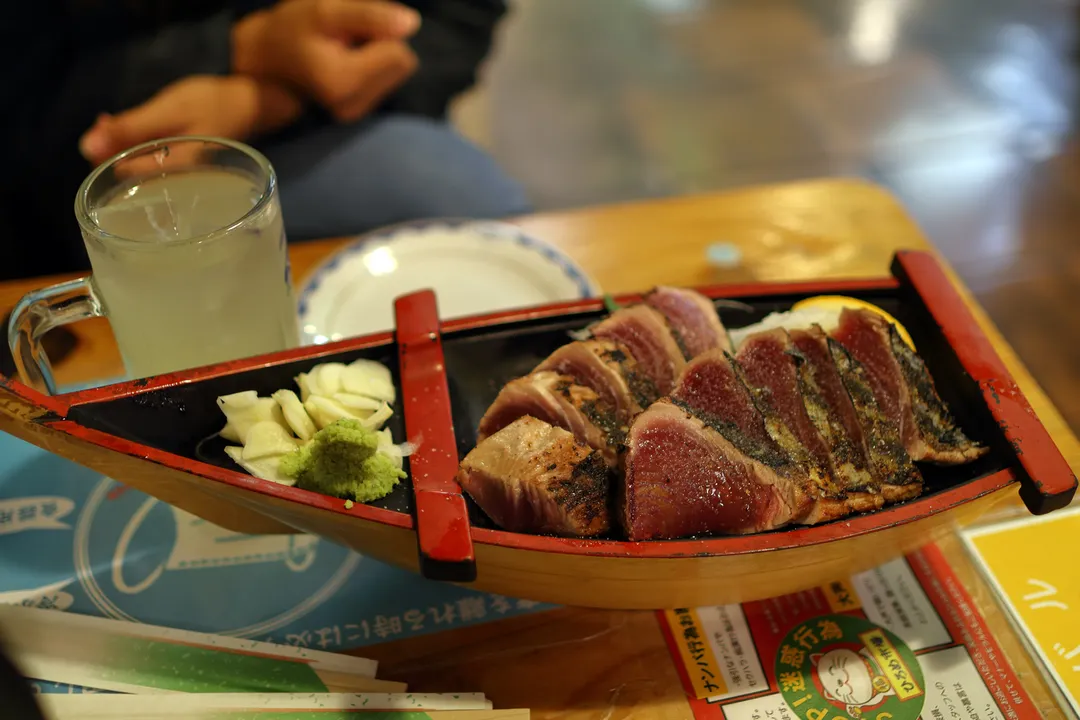Having departed from Matsuyama early in the morning, we first stopped by Uwajima and then continued via the Yodo Line until Kubokawa, where we changed trains for the final leg of the journey to Kōchi. The eponymous capital of Kōchi Prefecture is the only major city on the rugged southern coast of Shikoku, isolated from the more populous north by the mountain ranges in the island’s center.
It was nearly evening already and still drizzling when we arrived, so we first went to check in at the JR Clement Inn Kochi, a relatively new hotel opened in 2020 and conveniently located across the street from the station. Fortunately, the rain stopped while we were unpacking in our room, and I used the opportunity to go out and take a photo of the station building, which is one of the most architecturally interesting in Japan. It was fully rebuilt in 2008 as an elevated station, incorporating locally produced Japanese cedar in its arched roof.

Our plan for the evening was to have dinner at the Hirome Market, a sort of large food court which is the most well-known place to eat in Kōchi. To get there from the station, we rode a few stops on the Tosaden tram, the oldest such system still in operation in East Asia; service began in May 1904, three months earlier than the trams in Hong Kong. Most of the trams are classic models from the 1950s, although they have been upgraded with newer technologies such as air conditioning, LED signs, and card readers.

In the market, we ordered katsuo no tataki, or seared skipjack tuna, the representative dish of Kōchi Prefecture. The fish is cooked over an open flame in such a way that the outside becomes slightly charred while the inside remains raw, This contrast of textures elevates the dish above ordinary sashimi.

For dessert, we ate hojicha ice cream.

Back at the hotel, we took the opportunity to do our laundry (instrumental in keeping luggage to a minimum) since the previous two hotels hadn’t had coin laundry on premises.
The following morning, we got on the tram again toward Kōchi Castle, the final castle in our itinerary. Since it never saw combat and was spared from demolition in the Meiji era, Kōchi Castle still retains of its original structures and therefore is considered to be in the most complete state of preservation among all Japanese castles.

The keep was designed with comfort in mind rather than being purely for military use. Most notably, the top floor has an exposed balcony on all sides and was meant to be a place for the lord to enjoy the view rather than a fortified command post like in most other castles.

Visitors are allowed outside onto the balcony, unlike at Matsuyama Castle, where access to the balcony is restricted by barriers. Although Kōchi faces the Pacific Ocean on the map, there are hills separating the city center from the coast, so the ocean is not visible from the castle.

From the balcony, it is possible to get a closer look at the details of the roof. Many Japanese castles feature roof ornaments in the shape of a mythological creature with the head of a dragon and the body of a fish; these were believed to provide protection against fires, a significant hazard as wood was the primary construction material.


While we would have liked to explore other places around the city after visiting the castle, we had no time because we needed to get back to the station by noon. For lunch, we bought grilled mackerel sushi bento to eat on the train, and soon we were on our way north toward Takamatsu, the last destination in our loop around Shikoku.
